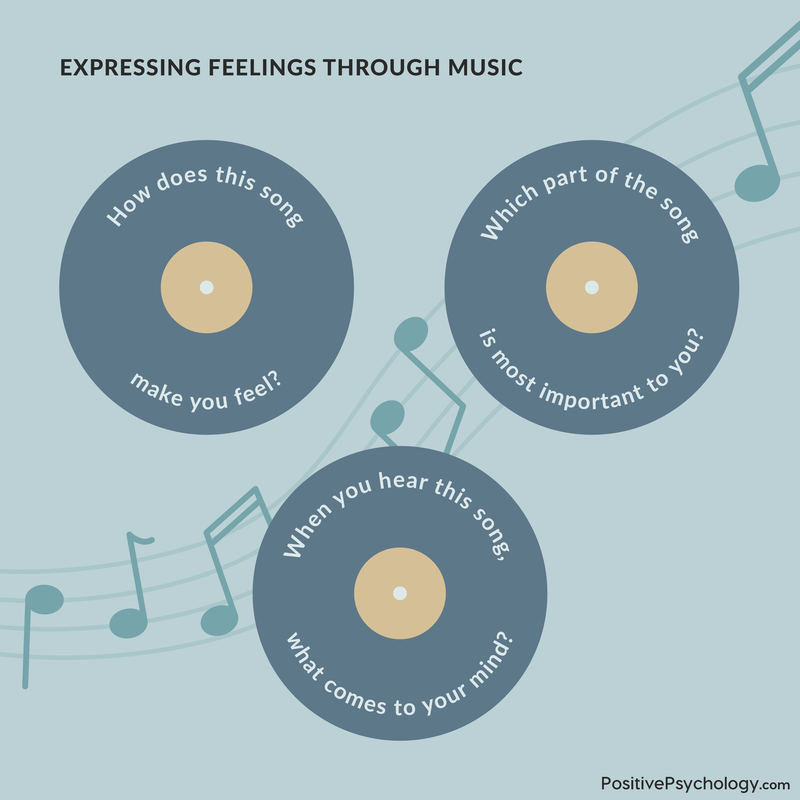What Is Self-Expression? (20 Activities + Examples)
 Do you ever stop to think about how you share yourself with others?
Do you ever stop to think about how you share yourself with others?
We all have our own unique quirks and traits, and we all have our own preferences and style for sharing pieces of ourselves with those around us.
You likely have a different level of sharing comfort with each person in your life—like a sort of security clearance in which those closest to you have a “Level 5” clearance while acquaintances have a “Level 1” clearance.
How we share and express ourselves to others forms the basis of our personality, as understood by everyone but us, and sets the tone for our entire lives. It’s a vital aspect of life to pay attention to, especially if you want to feel more understood and more in tune with the people you care about.
The way that we share ourselves is known as self-expression, and it turns out there are a lot of ways to do it. There are few “wrong” ways of expressing yourself, but there are some things you can do that give you a better chance of hearing and being heard than others.
Read on to learn how to more effectively express yourself to others, get in touch with your authentic self, and enhance your self-expression skills.
Before you read on, we thought you might like to download our three Self-Compassion Exercises for free. These detailed, science-based exercises will not only help you increase the compassion and kindness you show yourself but will also give you the tools to help your clients, students or employees show more compassion to themselves.
This Article Contains:
- What is the Meaning of Self-Expression? A Definition
- Self-Expression Theory in Psychology
- The Importance of Self-Expression
- Examples of Self-Expression
- How to Improve Self-Expression Skills
- Techniques for Developing Self-Expression
- Activities to Increase Self-Expression for Adults
- Project Ideas and Worksheets (PDF)
- Self-Expression Through Photography, Art, Music, Dance, Fashion and Poetry
- Does Social Media Promote Self-Expression?
- Books on Self-Expression
- 13 Self-Expression Quotes
- A Take-Home Message
- References
What is the Meaning of Self-Expression? A Definition
I think we all have a pretty good handle on what self-expression is, but let’s see how the experts define it:
“We define self-expression as expressing one’s thoughts and feelings, and these expressions can be accomplished through words, choices or actions.”
(Kim & Ko, 2007).
This is an intuitive definition—self-expression is, at its core, the action of expressing yourself, and it can take a wide variety of forms. You can use your words, your facial expressions, your body, your movements, clothing, actions, and possessions to express your authentic inner self.
Although the idea is simple, it seems that few fully grasp the importance of self-expression. We are all so bogged down with messages about how we should look, think, speak, and act; what we should eat and drink and study and do for fun; who we should associate with and who we should love or despise; and, indeed, who we should be deep down.
These constant missives about what we ought to do and who we ought to be can make it difficult to let go of expectations and simply be ourselves.
The last paragraph may have resonated with you—as it resonates with me—but as we’ll see later, the value we have for self-expression is not a universally shared value.
Self-Expression Theory in Psychology

For example, Kim and Ko (2007) note that self-expression is one of the most highly-regarded and venerated values in Western civilization due to the near-deification of “the individual” in our society. Not only is self-expression a vital practice of Western culture, it is also baked into the very roots of psychology. After all, psychology is all about the study of the mind, including the self, others, and groups of people.
The way we learn about the mind is through the expression of individuals—verbally or otherwise (Kim & Ko, 2007).
While those of us in the West have embraced individualistic norms and practices, including self-expression, other cultures have upheld collectivist values and—in some cases—placed little to no value on individualism. For instance, the Arab world is less prone to individualistic views and more likely to value tradition, religion, and authority (Inglehart et al., 2014).
Self-Expression Values
The differences across cultures and countries in the values they hold are fascinating; as noted above, countries in the Middle East are generally at the opposite end of the spectrum from Western countries on the two major axes of values:
- Traditional versus secular-rational values
- Survival values versus self-expression values (Inglehart et al., 2014)
Countries in North America and Western Europe generally fall on the secular-rational end (although the US and Ireland are two outliers when it comes to religion and tradition) and the self-expression end of the spectrums.
This indicates that Western countries tend to place less importance on traditional family values, religion, and obedience and more importance on environmental protection, social justice, and tolerance of different viewpoints and ways of life (Inglehart et al., 2014).
East Asia countries generally fall in the secular-rational/survival values section (as seen below), meaning they do not place as much importance on tradition and religion, but they place great value on economic and physical security.
The Inglehart-Welzel World Cultural Map – World Values Survey 7 (2022). Source: http://www.worldvaluessurvey.org/
In some places, self-expression values might be considered “indicative of egoism and weak social capital” instead of the key to happiness and actualization that many Western countries consider them to be (Welzel, 2010). Needless to say, the value placed on self-expression varies widely across cultures and countries.
Not only are the differences in self-expression values interesting, they raise a good point: can there be a comprehensive theory of self-expression that encompasses and explains self-expression across the globe?
Any Western-centric theory of self-expression will likely propose that a good dose of self-expression is not only healthy but necessary for fulfillment; on the other hand, a theory from an Asian or Middle Eastern country will likely place little importance on individual self-expression and may even see it as a deviant behavior!
The Importance of Self-Expression
Related to our discussion above, the importance of self-expression will vary depending on your location and the culture you are steeped in. As the World Values Survey showed, individualism is not highly valued in many countries. This fact makes the sentence below—a pretty tame idea by Western standards—anything from mildly strange to outright laughable in another context.
“The journey of self-discovery is the most important journey we can take”
(De la Huerta, 2014).
In many cultures, a journey of self-discovery would be considered odd, unusual, a waste of time, or even selfish; the people might say something like, “Why spend your time and effort on getting to know yourself? Just ask your family—they’ll tell you exactly who you are!”
However, given the largely Western audience of positive psychology, we’ll focus on the importance of self-expression in this context.
De la Huerta’s (2014) article provides a good brief overview of why self-expression is so important in our society. He argues that self-expression is a vital piece of the puzzle that is fulfillment in life; it allows us to be our best selves, reach our full potential, and make valuable contributions to the world we live in.
Authentic self-expression is how we embrace who we are, all the way from the positive traits and acts we keep on the surface to the darker and less valued pieces of ourselves that we bury deep down.
“Neuroscience is teaching us that ‘self-expression’ might be one – if not the most important ways for people to connect, navigate and grow with each other.”
Judith Glaser
Research Judith Glaser agrees on the importance of self-expression; she notes that authentic self-expression not only encourages us to be the best we can be, it allows us to work effectively with others. When we open up and express ourselves, we move from what she calls a state of protection (coddling our ego and manning our inner walls to protect ourselves) to a state of partnering (being open to sharing yourself with others and vice versa).
According to Glaser, this state is where we get our best and most innovative work done. Acting in alignment with our authentic selves activates our prefrontal cortex, giving us greater access to our higher-order abilities like creative and innovative thinking, problem-solving, and planning.
Two artists and educators, Jay M. Hanes and Eleanor Weisman, agree that self-expression is not only important for our relationship with ourselves and our relationships with others, it’s also vital for our work. They propose that we learn about ourselves through expressing ourselves, reflecting on our core self and engaging in creative learning that will benefit us in all walks of life and all disciplines and industries (Hanes & Weisman, 2016).
Examples of Self-Expression

This may sound like an exaggeration, but it’s not—people around you are expressing themselves every day in many ways, all you need to do is look for it.
Common ways that people in your life might express themselves include:
- Sharing details about their day and how it made them feel.
- Wearing an off-trend or outdated item of clothing, not to be cool and unique, but just because they like it.
- Playing guitar on the street without a hat, cup, or other container set up to take donations.
- Yelling to express their frustration about traffic or other hindrances to getting from A to B.
- Employing body language (either consciously or unconsciously) that tells you exactly how someone feels about him- or her-self, whether it’s tall and proud, slumped and defeated, or anywhere in between.
If you were so inclined, I’m sure you could come up with a list of 100 acts of expression that you saw in the last week alone. That’s probably not necessary—I’m sure you have a good grasp on what self-expression is—but it’s important to be reminded how often people share themselves with us and how often we have the opportunity to share ourselves with others in our daily lives.
Why can’t I express myself? – Rafael Eliassen
How to Improve Self-Expression Skills
As with most skills, the best way to improve your self-expression skills is to practice them! Self-expression skills include—but are not limited to—the following:
- Speaking
- Writing
- Body language
- Artistic endeavors (creating music, dancing, etc.)
Author and student learning guru John Ramos agrees; in an answer to the question-and-answer forum Quora, he provides the following pieces of advice (2016):
- Write (almost) everyday… It forces you to find the right words and expressions to convey your message.
- Emulate your favorite authors’ styles. (Note: you could also emulate your favorite poets, dancers, orators, musicians, etc.).
- Never lose a chance to speak in public.
- Apply winning formulas (particularly for public speaking, as there are many tricks and “secret weapons” to help you succeed).
All of the exercises, techniques, activities, and strategies listed below will give you great opportunities to practice your own self-expression skills!
Techniques for Developing Self-Expression

Peggy Schmidt from Scholastic Parents proposes the following seven strategies (and several techniques to implement these strategies) to encourage a child to build their self-expression skills:
- Teach your child to interpret spoken and body language.
a. Look at photographs of people expressing different emotions and discuss them.
b. Cut out a cardboard frame to act as a “mirror” and have your child(ren) mimic your expression and identify it.
c. Use everyday situations in your home to reinforce these lessons.
d. Make a game of identifying the emotions that go with a particular tone of voice. - Reinforce the concept of “personal space” by encouraging your child to:
a. Stay at arm’s length when he or she is talking to someone.
b. Make sure there’s space between him or her and other children when sitting together.
c. Avoid hugging someone he or she doesn’t know well.
d. Refrain from intruding on another child’s space by touching, pinching, or physically annoying him or her. - Explain the meaning of idiomatic expressions (explain jokes, idioms, puns, “turns of phrases,” etc.).
- Work on the art of conversation.
a. Initiate conversations with your child, particularly when there are no salient distractions around.
b. When you don’t understand something your child says, ask your child what he or she means.
c. Encourage your child to ask you questions and respond attentively to them.
d. Make good eye contact and ask your child to do the same.
e. Encourage your child to stay in control of his or her body when he is talking—no fidgeting or squirming!
f. Work at having successively longer conversations as he or she gets better at self-expression.
g. Have conversations with your child about things beyond routine, everyday stuff. - Model behavior that teaches the smart way to ask for help or a favor.
a. Explain what the favor is.
b. Rehearse what you’re going to say when you ask for the favor.
c. Have your child listen to your conversation. - Demonstrate the power of “please” and “thank you” as more than just good manners, but excellent tools.
- Teach your child how to listen and follow directions.
a. Get his or her attention through touch as well as your voice.
b. Be specific about what you want him or her to do.
c. Check for understanding when you ask your child to do something.
d. Compliment your child on following the directions and successfully completing the task (Schmidt, 2001).
With pre-teens and teens, you may want to upgrade your techniques and make things more organic. Follow these 10 tips from the Scholastic Parents Staff to encourage self-expression in your pre-teens and teens:
- Encourage your child to dance to express him- or herself (a dance-focused video game might be helpful here).
- Help your child design a website or blog to share his or her thoughts and feelings with family and friends, or include your child in the process of writing a family newsletter.
- Do a creative and expressive craft with your child, like creating jewelry or painting something without any constraints.
- Celebrate your child’s style by allowing him or her to dress however they’d like (given that it’s age-appropriate).
- Support your child engaging in sports, whether solo sports, team sports, or both.
- Encourage your child to mentor younger children to practice their own skills and do a good deed.
- Give your child a camera and let him or her snap away!
- Get outdoors and do a nature-oriented activity together (e.g., take a walk, go for a hike, do some gardening).
- Ask your child to take you on a guided tour of his or her classroom, the library, or somewhere else he or she spends a lot of time.
- Help your child make a video documentary about him- or herself, including their current likes and dislikes, strengths, interests, and passions (Eulberg, n.d.).
If you’re looking for techniques to enhance your own self-expression skills, there are some helpful general tips that can give you some guidance. Give these six tips a try:
- Speak your truth in the moment. Instead of looking back on a conversation and wishing you had been more honest and authentic, commit to being more honest and authentic in the moment. Promise yourself to speak your truth when the opportunity arises, but make sure to speak it with love and kindness.
- Widely define yourself. As psychiatrist Thomas Szasz notes, “…the self is not something that one finds. It is something that one creates.” Make sure that your definitions aren’t overly narrow or limiting and keep yourself open to new experiences, talents, interests, passions, and opportunities.
- Engage in creative techniques. Use techniques that harness your creativity to expand your potential and enhance your life. Try keeping a daily journal in which you write about whatever comes to mind, keeping an idea book that you carry with you all the time, creating mind maps to help you problem-solve, practicing brainstorming, and creating vision boards to motivate you to follow your dreams.
- Acquire self-knowledge – Know who you are. Don’t let yourself get too caught up in all of life’s little worries; take a break from your daily grind once in a while and assess your life and your feelings about it. Use introspection and reflection to make sure you never become a stranger to yourself.
- Pursue wants and passions voraciously. If your passions and dreams have become victims to the day-to-day stressors, dedicate yourself to keeping them off the metaphorical “back burner.” Make time to pursue your dreams and feed your passions—you won’t regret it!
- Develop a keen sense of reality. Your head may venture into the clouds, but your feet should stay firmly on the ground; keep in touch with reality and face your disappointments, setbacks, and unpleasant experiences head-on (“How to Live with Full Self-Expression”, n.d.).
These are somewhat general tips, but truly committing to them will help you become the master of your own self-expression. For some more specific, practical ideas on improving your self-expression, read on.
Activities to Increase Self-Expression for Adults

This section includes 15 activities that you may find useful (plus a link to 70 more!).
To work on improving your capacity for self-expression and encourage your practice of being authentically you, you may find this impressively long list of 75 group activities from the Expressive Therapist website helpful. It includes activities like:
- Inner Child: Draw yourself as a child on your paper. Add images and words to give this child everything that it needs, including a supportive nurturing parent.
- Inside – Outside Bags/Boxes: Decorate a bag or box with images and words on the outside to represent the qualities you show to the world. Decorate the inside of the bag or box with images and words that represent the inner qualities that are hidden to most people.
- Inspired Poem: Think of a quote that is meaningful to you and write it at the top of a piece of paper. (A list can be found at http://www.goodreads.com/quotes) Add your own lines below it that expand on the quote in the way you understand it – continue for the rest of the page. Find someone in the group to read your poem for you as you use movement or gesture to express the meaning of your poem.
- Four Elements of You: Discussion: Passion gives us the will to live and gives shape to our lives.
Fold your paper into four sections. Label each section, The Earth of Me, The Air of Me, The Fire of Me, and The Water of Me. Use image and color to express your passion in life as symbolized by the four elements. - Bardic Circle: Sitting in a circle, everyone takes a turn sharing something with the group, such as performing a song, a dance, a poem, a joke, or an interesting fact, or teaching a new skill. Everyone is encouraged to be supportive and attentive when others share.
If you’re working your way through addiction, rehabilitation, recovery, or perhaps even striving towards post-traumatic growth, these activities from Summit Behavioral Health (2015) might help:
- Listen to music to help you identify your feelings; if you are in a group, share out what you learned.
- Take a mindful walk (stay aware of yourself and your surroundings, make observations about your environment, and avoid judgment as much as possible).
- Write a new ending to a previous event, particularly an event that involved conflict, bad decisions, or mistakes on your part. This will help you learn how to make better choices and stay more optimistic.
- Build, create, or restore something to encourage yourself on your own journey toward a healthier, happier you.
- Create a visual journal using signs, symbols, drawings, or anything else to express your feelings aside from words.
If you’re interested in enhancing your self-expression specifically in the workplace, Judith Glaser has some great suggestions (2016):
- Consider taking on a project like Glaser’s Children’s World, in which she and her team collected stories and pictures from schoolchildren, compiled them into a book, and actually published it (side note: it included material from over 500 students!).
- Kick off a meeting by asking people to share a recent personal story and a business story that they are enthusiastic or excited about.
- Complete the “What I Respect About You and What I Need From You” exercise to get to know your team better and identify strengths, needs, likes and dislikes, and how to avoid certain pitfalls with your colleagues.
- Collect your team’s success stories and publish them in a book, pamphlet, or brochure.
- Publish your organization’s success stories on your company intranet and solicit advice and suggestions from your organization’s members on how to achieve future success.
Music is considered a universal “language of the emotions” (Cooke, 1959).
Through music, we can evoke complex emotions and create mood states that might be difficult to categorize as positive or negative by only using words. Even before a baby is born, exposing a fetus to music helps the brain develop, calms and soothes, brings up emotions of love and joy, and strengthens the mother-child relationship (UNICEF, 2022).
Scientist John Stuart Reid (2019) discovered that music can even support our bodies to heal naturally by awakening our red blood cells. An increased red blood cell amount leads to a decrease in chronic pain, high blood pressure, poor immune system, stress, depression, and traumas.
Ask your client to write down three songs that describe how they are feeling at the moment. Reflect on the following questions with your client:
- When you hear this song, what comes to your mind?
- How does this song make you feel?
- Which part of the song is the most important to you?
This exercise aims to help your clients communicate feelings and concerns by using music as a multi-dimensional medium to “translate” personal experiences. Because your client will identify and describe the upcoming emotions, emotional awareness can be further developed through this technique.

Project Ideas and Worksheets (PDF)
Those fond of making lists, checking boxes, drawing things out, and any other form of expression that involves using a pen and paper might find these projects and worksheets especially useful. There are also a few worksheets that you can use with your child to encourage their own capacity for self-expression. Read on to get some ideas!
Your Pet Worksheet
This worksheet encourages kids to think about how they express their thoughts and ideas. It can be used to encourage them to consider what details are important and which are superfluous, help them figure out how to best get the words into their head onto paper, and show them how to tie it all together into a clear, comprehensive narrative.
First, your child can fill in the “Main Idea” bubble in the center, writing about their pet, noting what kind of pet they have and what is most important to know about that pet.
Next, they can work on filling in the supportive details. The prompts can help them figure out what they should be writing and help them comes up with more ideas; these prompts include:
- How long have you had your pet?
- What is your pet’s name?
- Describe your pet’s personality—playful, loving, quiet, funny, loyal?
- What does your pet look like? Describe your pet.
Click here to read more about this worksheet or download it for your child (please note that a free account with Education.com is required to download some of their free resources).
All About Me Worksheet
This is another worksheet for kids that is simple, easy to complete, but helpful for your child’s writing and self-expression skills. It can also be helpful for handwriting practice, engaging in creative thinking, and breaking the ice with a new classmate.
First, the worksheet asks for just the basics:
- The child’s name
- The child’s place of birth
Next, the worksheet moves on to the more individual aspects of preferences and interests:
- Favorite colors
- Favorite hobbies
- Favorite foods to eat
- Favorite place to visit
- Favorite movie
Finally, the last three prompts are where your child can really get thoughtful, creative, and personal:
- “I laugh and smile when…”
- “I will make the world a better place by…”
- “My dream is to…”
To download this worksheet for use with your own child, click here (this worksheet is hosted on Education.com, which requires a free membership for the use of some of their resources).
What Makes Us Alike & Different
A final worksheet for kids focuses on similarities and differences between the child and others. Completing this worksheet can help your child not only learn more about other people, other cultures, and other ways of life, but it can also help him get to know himself better.
First, the worksheet explains that there are tons of people in the world, but we’re all different. We might come from different cultures, countries, or backgrounds, but we all have at least a few things in common.
Next, the child is instructed to compare him- or herself to a friend or family member and consider these questions:
- What makes you alike?
- What makes you different?
In the space below these instructions is a table split into three columns, one with each of the following headings:
- What makes you different?
- How you are alike
- What makes your friend different?
For each column, your child should think of some things that apply. How is she different from her friend? Where do the differences come from? Are they superficial, or pretty big differences?
Next, she can think about how she and her friend are alike. What do they have in common? What can they agree on or relate to one another about?
When your child has completed this worksheet, he will be more knowledgeable about different cultures, backgrounds, and lifestyles than before, and hopefully on his way to being tolerant and friendly to all.
Click here to download this worksheet from Education.com as well (like the previous worksheets, it requires a free membership to download).
Self-Expression Worksheet
This worksheet comes from SpiritSpring Coaching and offers you an opportunity to learn more about self-expression, get some suggestions on how to practice it more often, and work on engaging your self-expression muscles, so to speak. It references religion since SpiritSpring is a religious organization, but the activity itself does not require faith in any religion or spiritual being to successfully complete it.
First, you will respond to 10 statements about your current self-expression on a 3-point scale (seldom true, sometimes true, and often true). These statements are:
- I am inspired by and through authentic self-expression.
- I communicate what is in my heart.
- I express wholeness; there is no part of me or my life that is not fully embraced.
- My own words and actions reflect consciousness and clarity.
- My communication is honest, timely, and complete. I do not deceive, delay, or diminish when I speak my truth.
- I know when I am expressing myself authentically and when I’m not.
- I invite honesty and truth-telling.
- I am aware of the impact of my words and actions.
- My words and actions contribute in a positive way to myself and others.
- There is integrity between who I am, what I say and how I act.
For each statement, you will pick a response on the scale mentioned above and also provide an example of the statement in action in your life.
Next, you will answer some questions and respond to some prompts to help you get even more in touch with yourself and how you generally express yourself. These questions and prompts are:
- Describe a current situation in your life where you are being real.
- What’s at stake in that situation or relationship? What could you gain or lose?
- Describe a current situation where you have not been being real?
- What’s at stake in that situation? What could you gain or lose?
- What could you do to turn the second situation around, so that you’re being real?
By completing this worksheet, you will have discovered your approximate level of skill and practice in self-expression, identified an area in which you are best at expressing yourself and an area in which you are lagging in self-expression and come up with a plan to work on your weaknesses when it comes to expressing yourself. That’s a lot of punch to pack into one worksheet!
To give it a try, click here (clicking the link will begin a download of the worksheet).
The Five Messages Worksheet for Self-Expression and Self-Inquiry
Finally, this worksheet from The Seven Challenges Workbook is a great way to work on your self-expression skills. It covers the five main “messages” or elements of self-expression and guides you through identifying and considering each one.
The idea is that there are five “I messages” that correspond to five elements of experiencing and communicate different things to those around you.
The five elements and messages are:
1. “What actions, events, and/or sensations am I seeing, hearing, doing, remembering or otherwise sensing (the facts without evaluation)?”
As I (or when I) see (hear, remember, take action about)…
2. “What basic emotions am I feeling (glad, sad, mad, delighted, frustrated, proud, sorry, ashamed, grateful, etc.) about those actions/events?
…I feel (or felt)…
3. “What interpretations, evaluations, wants, hopes, needs, and/or dreams of mine help to evoke and support my feelings?”
…because I…
4. “What action, information, discussion, help, or commitment do I want, would I like, and/or do I want to request now?”
…and now I want (want to request)… [Something doable]
5. “What positive results or personal fulfilment do I envision that action, discussion, information, or commitment leading to?”
…so that I can / so that we can / in order for me or us to…
Filling in the blanks on this worksheet will help you take a peek into your inner experience and understand it better in addition to expressing it better. At the end, you’ll have a sort of sentence describing your experience. It will look something like this, although customized to your situation:
“As I see [element 1]… I feel [element 2]… because I [element 3]… and now I want [element 4]… so that I can [element 5].”
This exercise is a great way to get in touch with your inner self and figure out what you want, what you value, your thought patterns and emotional tendencies, and discover how you can move forward.
Click here to download the worksheet (an automatic download will initiate when you click the link).
Self-Expression Through Photography, Art, Music, Dance, Fashion and Poetry

We often think of self-expression as involving speech and perhaps some actions as well—provided they are creative.
People have found wonderful outlets for self-expression through speaking and writing prose, but also through practicing photography, creating art, creating or sharing music, choreographing a dance routine (or coming up with some moves on the spot!), creating and/or wearing pieces that reflect your inner self, and crafting meaningful poems.
It’s true that creative activities are often a great way to express yourself, but don’t forget about the many other ways available to you! In truth, anytime you are behaving in accordance with your true, authentic self and doing anything other than sitting still, you are likely engaging in self-expression—although performance artists have certainly been able to express their thoughts and ideas through the act of simply sitting!
You might be thinking of another pretty obvious method we all have of expressing ourselves: social media. It is indeed one of our many options, but it could prove to be a double-edged sword.
Does Social Media Promote Self-Expression?

There’s some debate about that, with persuasive arguments both for and against.
As far as research goes, researchers have studied the relationship between self-esteem, self-expression, and usage of the popular social media site Facebook, and found that social media may be seen as a valuable tool for expressing oneself for those with low self-esteem and/or social anxiety (Leighton, Legate, Lepine, Anderson, & Grahe, 2018).
However, as rapidly as social media changes, so too does our understanding of its effects on us; by 2016, social media users were likely to report that Instagram and Snapchat were useful tools for self-expression, but Facebook and Twitter were not (Leighton et al., 2018).
The bottom line? Social media certainly facilitates expression! But how much of that expression is an authentic expression of our true selves? That question has yet to be answered.
Books on Self-Expression
If you’re intrigued by self-expression or want to learn more about how to boost your own capacity for self-expression, you might benefit from some further reading. Take a look at these 9 books on the subject and see if any of them catch your fancy:
- Self-Expressions: Mind, Morals, and the Meaning of Life by Owen Flanagan (Amazon)
- A Big New Free Happy Unusual Life: Self Expression and Spiritual Practice for Those Who Have Time for Neither by Nina Wise (Amazon)
- Illness and the Art of Creative Self-Expression: Stories and Exercises from the Arts for Those with Chronic Illness by John Graham-Pole (Amazon)
- Creative Photography Lab: 52 Fun Exercises for Developing Self-Expression with your Camera by Steve Sonheim and Carla Sonheim (Amazon)
- Mastering the Art of Self-Expression by Laura Thoma (Amazon)
- Self-Expression by Mitchell S. Green (Amazon)
- Emotions Revealed: Recognizing Faces and Feelings to Improve Communication and Emotional Life by Paul Ekman (Amazon)
- Creating Mandalas: For Insight, Healing, and Self-Expression by Susanne F. Fincher (Amazon)
- Affirmations #1 For Health, Wealth, Relationships, and Self-Expression by Joseph Murphy (Amazon)
13 Self-Expression Quotes
To get motivated, inspired, or in touch with your authentic self, sometimes a good quote can help. Check out these 13 quotes below.
“Good things will come from self-expression.”
John Cho
“If you have the words, there’s always a chance that you’ll find the way.”
Seamus Heaney
“Everybody is talented because everybody who is human has something to express.”
Brenda Ueland
“If there’s one theme in all my work, it’s about authenticity and self-expression. It’s the idea that some things are, in some real sense, really you—or express what you and others aren’t.”
Bernard Williams
“There is a vitality, a life force, an energy, a quickening that is translated through you into action, and because there is only one of you in all time, this expression is unique. And if you block it, it will never exist through any other medium and will be lost.”
Martha Graham
“No man has the right to dictate what other men should perceive, create or produce, but all should be encouraged to reveal themselves, their perceptions and emotions, and to build confidence in the creative spirit.”
Ansel Adams
“Self-expression should not be a challenge that demands extraordinary talent but should be a right accessible to all.”
Deeyah Khan
“Self-expression is always a right, but it’s still not there to be abused.”
Isaac Hayes
“If we don’t believe in freedom of expression for people we despise, we don’t believe in it at all.”
Noam Chomsky
“Everyone has their own ways of expression. I believe we all have a lot to say, but finding ways to say it is more than half the battle.”
Criss Jami
“To the poet fated to be a poet, self-expression is as natural and as involuntary as breathing is to us ordinary mortals.”
Octavio Paz
“If you copy then it is not self-expression.”
Michael Schenker
“I want freedom for the full expression of my personality.”
Mahatma Gandhi
A Take-Home Message
I hope you found this piece helpful and informative, and I hope that I successfully expressed myself and my thoughts on this subject.
If you leave with one takeaway, let it be this: there is no downside to furthering your ability to express yourself, but there are tons of potential benefits. Learning to understand yourself and more effectively share that understanding with others is a fundamental part of being human, and we’re so lucky that we have so much influence over how that process unfolds!
Take advantage of that fact and you will avoid looking back with regret when you think about all the things you should have said.
What are your thoughts on self-expression? Do you think it’s one of the most important values in our society? Is it one of the most important values to you? How do you like to express yourself? Let us know in the comments!
Thanks for reading, and best of luck in enhancing your capacity for self-expression!
We hope you enjoyed reading this article. Don’t forget to download our three Self Compassion Exercises for free.
- Cooke, F. L. (1959). The value of psychological treatment in general practice. Journal of the Royal College of General Practitioners, 2(3), 231-238
- De la Huerta, C. (2014). The power of self-expression. The Huffington Post. Retrieved from https://www.huffingtonpost.com/christian-de-la-huerta/the-power-of-self-expression_b_5167635.html
- Eulberg, E. (n.d.). 10 activities to encourage self-expression in pre-teens. Scholastic Parents. Retrieved from https://www.scholastic.com/parents/family-life/social-emotional-learning/social-skills-for-kids/10-activities-to-encourage-self-expression.html
- Glaser, J. E. (2016). Self-expression: The neuroscience of co-creation. Psychology Today. Retrieved from https://www.psychologytoday.com/us/blog/conversational-intelligence/201602/self-expression
- Hanes, J. M., & Weisman, E. (2016). Experience and expression. Education and Culture, 32(2), 64-79.
- “How to Live with Full Self-Expression.” (n.d.). Virtues for Life. Retrieved from http://www.virtuesforlife.com/how-to-live-with-full-self-expression/
- Inglehart, R., C. Haerpfer, A. Moreno, C. Welzel, K. Kizilova, J. Diez-Medrano, M. Lagos, P. Norris, E. Ponarin & B. Puranen et al. (Eds.). 2014. World Values Survey: Round Five – Country-Pooled Datafile Version: www.worldvaluessurvey.org/WVSDocumentationWV5.jsp. Madrid, Spain: JD Systems Institute.
- Kim, H. S., & Ko, D. (2007). Culture and self-expression. In C. Sedikides & S. Spencer (Eds.), Frontiers of social psychology: The self (pp. 325-342). New York, US: Psychology Press.
- Leighton, D. C., Legate, N., LePine, S., Anderson, S. F., & Grahe, J. (2018). Self-esteem, self-disclosure, self-expression, and connection on Facebook: A collaborative replication meta-analysis. Psi Chi Journal of Psychological Research, 23, 98-109.
- Ramos, J. (2016). Answer: How do I improve my expression skills? Quora. Retrieved from https://www.quora.com/How-do-I-improve-my-expression-skills
- Reid, J. S. (2019). Cymatics, the science of visible sound and vibration. Journal of Science and Healing, 15(4), 262-269.
- Schmidt, P. (2001). Communication is key: Try these 7 strategies to build your child’s self-expression skills. Scholastic Parents. Retrieved from http://www.scholastic.com/browse/article.jsp?id=1439
- Summit Behavioral Health. (2016). 5 activities of self-expression to make dealing with emotions in recovery easier. Summit Addiction Recovery Blog. Retrieved from https://www.summitbehavioralhealth.com/blog/5-activities-self-expression-make-dealing-emotions-recovery-easier/
- UNICEF. (2022). The State of the World’s Children 2022: Childhood under threat. UNICEF. https://www.unicef.org/media/118821/file/SOWC-2022.pdf
- Welzel, C. (2010). How selfish are self-expression values? A civicness test. Journal of Cross-Cultural Psychology, 41, 152-174.
Let us know your thoughts
Read other articles by their category
- Body & Brain (49)
- Coaching & Application (57)
- Compassion (26)
- Counseling (51)
- Emotional Intelligence (24)
- Gratitude (18)
- Grief & Bereavement (21)
- Happiness & SWB (40)
- Meaning & Values (26)
- Meditation (20)
- Mindfulness (45)
- Motivation & Goals (45)
- Optimism & Mindset (34)
- Positive CBT (28)
- Positive Communication (20)
- Positive Education (47)
- Positive Emotions (32)
- Positive Leadership (18)
- Positive Parenting (4)
- Positive Psychology (33)
- Positive Workplace (37)
- Productivity (16)
- Relationships (46)
- Resilience & Coping (36)
- Self Awareness (21)
- Self Esteem (37)
- Strengths & Virtues (31)
- Stress & Burnout Prevention (34)
- Theory & Books (46)
- Therapy Exercises (37)
- Types of Therapy (64)







What our readers think
A note that “e. Encourage your child to stay in control of his or her body when he is talking—no fidgeting or squirming!” is harmful – it was from an old source and it’s since become consensus that stimming is healthy self-regulating behavior and that suppressing it can cause or worsen things like anxiety, over- or understimulation, difficulty with attention, and excess energy, especially for neurodivergent people.
I’d caution against teaching “d. Refrain from intruding on another child’s space by touching” too – research shows that cultures that avoid physical contact have worse wellbeing. So it’s better to teach children to keep physical contact to friendly, casual settings and people they get along with and to check in and ask others if they feel comfortable with it.
I really appreciated this well written article, especially how parents can help children. I also appreciated that you mentioned just sitting and doing nothing is a form of self- expression, or whatever you feel is a way of expressing yourself. For example, if you are inclined toward helping others, then volunteering at a food bank or for Hospice would be considered a form of self- expression. There are countless things that only require a person’s time in order to express themselves. This country is filled with people like that. We all learned that during the early days of the pandemic when we were in quarantine. We saw so many ways people were giving of their talents and their time to make life easier for all of us. If that isn’t a form of self- expression, I don’t know what is! I’ll never forget Andrew Lloyd Weber showing us all his musicals for everyone to enjoy, and inviting others to send videos of them singing his songs. Or John Krasinski starting “Some Good News,” to uplift us all. They shared their self-expression with everyone. The newscasters even gave us ideas to try something new. That greatly enhanced the self-expression of the entire country, and helped us to see how important it is in our lives, even with little or no money. We saw the highest form of self -expression; love in action. Doesn’t cost a dime. Thanks for writing this article to remind us all of that .
Thank you so much for the article. You gave us very useful information and almost everything,
one needs to look for to understand self-expression. Your content, especially at the end was intended for children and parents and for adults too, which is good. I want to point out that Self-Expression in western nations is not as good as you presented since capitalism and materialistic mindset is still highly prevalent in western nations(Side note- you used all researches really well to explain).Also I would like to invite you to study Indian traditional philosophies and teachers who placed the importance of self-realization as the basis of their traditions.
Thank You.
This was a beautiful article. Welldone!!
Thank you, helpful article
Thank you. This article opened a whole new space in my head
Great Article! Very helpful. I see the effort you have put into it. Congrats!